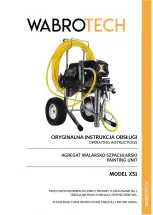
Page
12
of
48
1.3.4 Mechanical Hazards
If equipment has been installed to manipulate the component and/or spray gun, it is
important that it is designed to protect the operator from mechanical hazards. It is possible for
the operator to be struck by a moving table or manipulator, to be crushed against the wall of
the booth, or to become entangled in rotating machinery. Serious injury could occur. Trailing
cables and other obstructions present a tripping hazard, and because of the relatively confined
area of a spray booth, and the close proximity to machinery, the consequences may be
serious.
Key Hazards:
Entanglement, being struck by machinery, trips and falls.
1.3.5 Electrical Hazards
Electricity can give rise to electric shock, fire, explosion and burns. It can also lead
to falls and muscular injury. The risk of death from electric shock is related to the current that
passes through the body, and the path it takes.
Voltages below 50Vac or 120Vdc are considered safe, except in conducting environments. A
typical spray booth is a conducting environment. However, the power supply for the equipment
will usually be fed from a higher voltage supply, typically 240V or 415V, which must always be
considered hazardous.
Other related causes of electrical accidents include poor placement of cables. These may
become trapped on booth doors, or damaged whilst on the floor, leading to exposure of the
live conductors. Electrical apparatus can also be the source of sparks, and like electrostatic
discharges can ignite explosive mixtures; additionally they can cause a fire, which, with gases
present, could be dangerous.
Key Hazards:
Electric shock, explosion, fire, burns.
1.3.6 OZONE
Arc systems with much brighter arc intensity operate between 280 and 220 nm,
also called the UV-C region. Arc systems operating in this range also generate ozone. Ozone
is formed from dioxygen by the action of ultraviolet light and also atmospheric electrical
discharges.
It is a colourless gas with a sharp characteristic odour; it can be smelled at concentrations
below the permissible exposure level. The odour is generally detectable by the human nose at
concentrations of 0.02 and 0.05 ppm. It has a density of 1.244 g/l, around 1.6 times heavier
than air.
Ozone affects the body by being inhaled or by irritating the eyes, nose and throat. When a
person is exposed to very low concentrations of ozone, the person may notice a sharp
irritating odour. As the concentration increases, the ability to smell it may decrease. Irritation of
the eyes, dryness of the nose and throat, and cough may be experienced. If the Ozone
concentration continues to rise, more severe symptoms may develop. These may include
headache, upset stomach or vomiting, pain or tightness in the chest, shortness of breath or
tiredness, which may last for several days to weeks. Finally, with higher levels of exposure, the
lungs may be damaged and death may occur.
The following limits are widely accepted (USA, Sweden, UK and other parts of Europe):
- 8 hour per day/5 days per week (occupational exposure limit) - 0.1 ppm
- 15 minutes (short term exposure limit) - 0.3 ppm
Key Hazards:
Irritation, headache, vomiting, lung damage, death.
Содержание ARC150-2310D
Страница 1: ...Page 1 of 48 ssue 21 11 11 ...
Страница 14: ...Page 14 of 48 SECTION 2 THE EQUIPMENT 2 1 System Configurations ...
Страница 41: ...Page 41 of 48 SECTION 5 FAULT FINDING 5 1 Operational Troubleshooting ...
Страница 43: ...Page 43 of 48 SECTION 6 ILLUSTRATED PARTS LIST 6 1 Main Components 6 2 CG Spray Head ...
Страница 46: ...Page 46 of 48 SECTION 7 INFORMATION TABLES 7 1 Typical Performance Figures ...













































